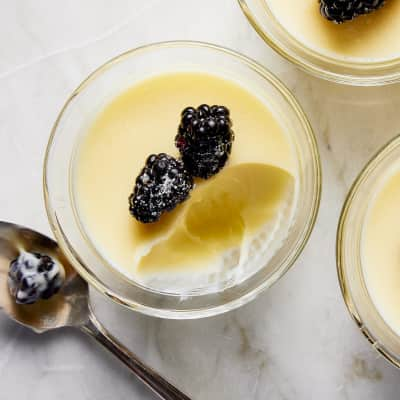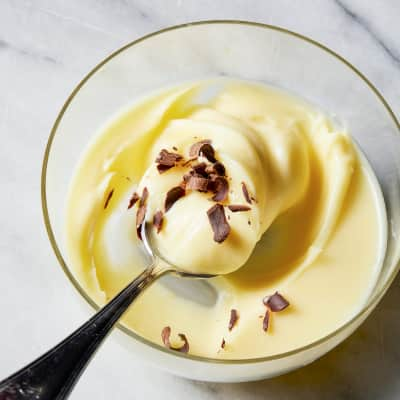One of the first dessert recipes I developed for Cook’s Illustrated, for the March/April 2016 issue, was posset, an old-time British treat that I hadn’t previously encountered, but which quickly became a favorite of mine—and of our readers. In the Middle Ages, posset was a milky medicinal drink, potable but not especially appealing. Today’s posset is something altogether different: a chilled dessert with an impossibly satiny texture, like the silkiest mousse or pudding, but easier to make since it contains only cream, sugar, and fresh lemon. Without egg yolks, flour, cornstarch, or gelatin to coax it into setting, its transformation into a velvety delight seems like magic. But really, it’s science.
Sign up for the Cook's Insider newsletter
The latest recipes, tips, and tricks, plus behind-the-scenes stories from the Cook's Illustrated team.
The Posset Lab
Want to create more posset flavors? Make a citric acid solution—dissolve 20 grams citric acid in 30 grams of water—and use it to bring any juice to a pH of 2.6 (the sweet spot to ensure that the posset sets and won’t be too tart). Start with 1/4 teaspoon of solution per 6 tablepoons of juice and then check the level with a pH meter (purchase online or at hardware stores). Share your #possetlab creations with us on Instagram @cooksillustrated!

My recipe goes like this: Boil heavy cream, sugar, and lemon zest until it’s reduced to precisely 2 cups and then add lemon juice. Once the mixture has cooled, strain out the zest, portion the citrusy dairy into individual cups, and chill. The lush, buttery-smooth result is firm enough to hold its shape on a spoon and sings with bright, lemony flavor.
The way it all works is fascinating: Lemon juice acidifies the cream, causing its casein proteins to link up. The cream’s fat (at least 36 percent, as opposed to whole milk’s 3.25 percent) interferes with the casein proteins’ ability to form clumps (as milk might), so it thickens to a creamy consistency. Sugar contributes to the viscosity and luxurious mouthfeel.
Boiling the cream mixture is key for three reasons. First, it evaporates water, allowing more lemon juice to be added for a sunnier taste. Second, boiling creates a firmer texture by denaturing whey proteins, which help link the casein proteins together. Third, boiling to a specific volume ensures consistent results every time you make the dessert (trust me, you’re going to make it often).
Because a properly set posset needs a strong acid, you don’t often see it prepared with anything other than lemon juice (pH of about 2.6), unless lemon juice is added to other fruit juices to boost acidity—but this then obscures their flavor.
When I took this conundrum to Senior Science Research Editor Paul Adams, he knew exactly what to do: add citric acid. The chief acid in lemons and limes, citric acid doesn’t lend a citrusy taste; it just wakes things up with zippy acidity. With this powder in hand (it’s available at markets and online), I hoped to create possets from a slew of fruit juices.
Once-Forbidden Fruit
I set up shop in my kitchen, using a pH meter to measure a wide variety of juices: freshly squeezed lime, orange, and grapefruit, and bottled grape, apple, cranberry, cherry, and pineapple; they ranged from 2.5 to 4.1. I then homed in on the choices that seemed most suited to posseting.
Because my recipe calls for only 6 tablespoons of juice, I needed strong flavors to hold their own against the heavy cream. Along with cranberry and pineapple juice, I pursued all of the citruses because I could infuse the cream with zest—which contains fragrant oils that are more resistant than juice to breaking down under heat—for nuanced complexity. Thanks to pHs of 2.5 and 2.6, respectively, I was able to directly swap the lime and cranberry juices into my lemon posset recipe. However, test batches of grapefruit (pH 3.1), orange (pH 3.6), and pineapple (pH 3.9) confirmed that these variations would not set without the help of citric acid.
Citric Acid Makes Any Juice Possetable

The elegant magic of posset is that it thickens itself: The cream in the recipe is packed with casein proteins that naturally stay separated and suspended in the liquid. But when the dairy’s pH—a measure of how acidic it is—drops from a near-neutral 6.8 to below 5.0 thanks to the addition of lemon juice (pH 2.6), those proteins knit together and turn the liquid into a tender, rich gel. But when we wanted to make posset with other juices, such as grapefruit (pH 3.1) or pineapple (3.9), the mixture never got acidic enough to cause the cream’s protein to aggregate into that delicate gel. The solution: Adjust each juice with citric acid to bring its pH down to that of lemon juice. The result: perfect posset from any fruit. –Paul Adams
I started by dissolving 3/4 teaspoon of the powder in the juices, which lowered the pHs to about 2.2. These possets set, but were mouth-puckeringly tart.
Adams, who by this point I had nicknamed “the acid master,” suggested a failproof way to measure an even smaller amount of citric acid, which varies in grain size from brand to brand: Make a solution, measured by weight. When working with tiny amounts of powerful ingredients, he explained, precision is paramount. It’s especially crucial for posset, in which small deviations in pH can ruin the flavor and/or texture.
To make the solution, I dissolved 20 grams of citric acid in 30 grams of water. One-quarter teaspoon of the liquid dropped the pH of 6 tablespoons of grapefruit juice to 2.74, too high, and the posset was runny. One-half teaspoon lowered it to 2.59, just right. The same amount also reduced the pineapple and orange juices to about 2.6. (Citric acid behaves in such a way that a modest amount will drop the pH of most juices to about 2.6—but you’d have to add a lot more citric acid to drop it much lower.)
Fancy Finishes
Using this formula, I churned out a plethora of possets, pairing each with a garnish: sweet-salty candied pistachios to grace the elegantly bitter grapefruit; coconut flakes atop pineapple for a piña colada–inspired treat; shaved bittersweet chocolate with orange, which had Creamsicle vibes; macerated blackberries with the tart lime; and a graham cracker crumble with the fruity cranberry. Now that you too have the scientific know-how, what flavors will you create?


Lime Posset with Sugared Blackberries
Years ago, we fell hard for the bright, velvety simplicity of lemon posset. Now we've used science to prepare this favorite in an array of fruity flavors.
Get the Recipe
Pineapple Posset with Toasted Coconut
Years ago, we fell hard for the bright, velvety simplicity of lemon posset. Now we've used science to prepare this favorite in an array of fruity flavors.
Get the Recipe
Cranberry Posset with Graham Cracker Crumbs
Years ago, we fell hard for the bright, velvety simplicity of lemon posset. Now we've used science to prepare this favorite in an array of fruity flavors.
Get the Recipe
Grapefruit Posset with Candied Pistachios
Years ago, we fell hard for the bright, velvety simplicity of lemon posset. Now we've used science to prepare this favorite in an array of fruity flavors.
Get the Recipe
Orange Posset with Shaved Bittersweet Chocolate
Years ago, we fell hard for the bright, velvety simplicity of lemon posset. Now we've used science to prepare this favorite in an array of fruity flavors.
Get the Recipe
Grapefruit Posset with Candied Pistachios
Years ago, we fell hard for the bright, velvety simplicity of lemon posset. Now we've used science to prepare this favorite in an array of fruity flavors.
Get the Recipe
